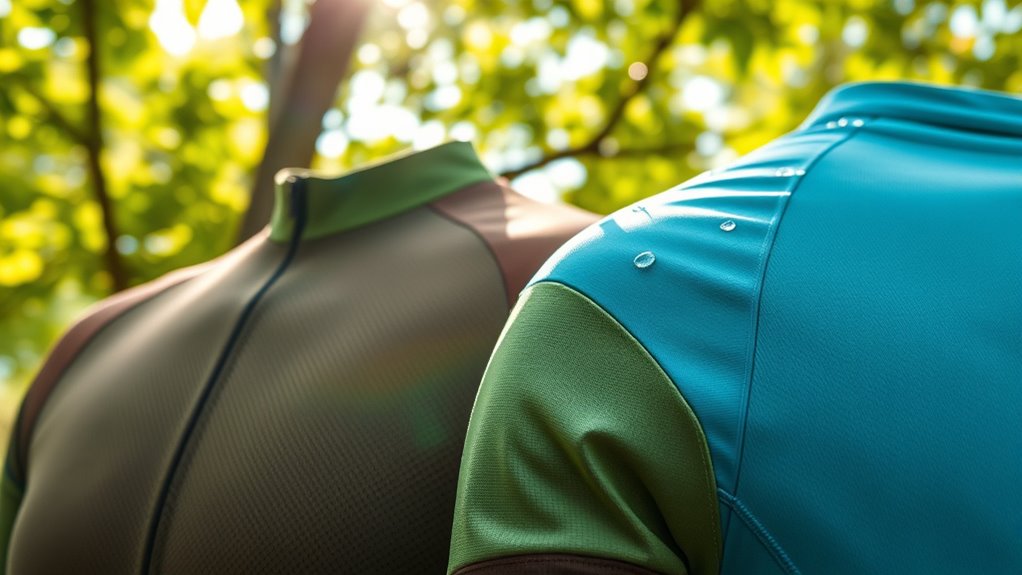Eco-friendly fabrics in cycling apparel blend high performance with sustainable production practices that minimize environmental harm. These materials, like organic cotton, hemp, and bio-based polymers, are designed to decompose naturally and reduce long-term waste. Sustainable dyeing methods recycle water and use eco-friendly dyes, cutting down chemical runoff. By choosing gear made with these fabrics, you support cleaner waterways and a healthier planet. Keep exploring to discover how these innovations are shaping a greener industry for cyclists everywhere.
Key Takeaways
- Eco-friendly fabrics like organic cotton, hemp, and bio-based polymers are increasingly used in cycling apparel for sustainability and performance.
- Sustainable dyeing methods recycle water and reduce chemical runoff, minimizing environmental impact in fabric production.
- Biodegradable textiles decompose naturally, reducing long-term waste and supporting a circular economy in cycling gear manufacturing.
- Brands adopting environmentally responsible practices lower energy use and chemical waste, promoting eco-conscious manufacturing processes.
- Using eco-friendly fabrics encourages industry-wide adoption of sustainable materials, benefiting waterways, ecosystems, and rider health.

Have you ever wondered how your clothing choices impact the environment? When you pick cycling apparel, it’s worth considering not just performance and comfort but also the environmental footprint of the fabrics you choose. Eco-friendly fabrics are gaining popularity, and understanding their benefits can help you make more sustainable decisions. One key aspect is sustainable dyeing, which minimizes water usage and reduces harmful chemical runoff. Traditional dyeing processes can consume vast amounts of water and release toxic dyes into rivers and soil. In contrast, sustainable dyeing techniques use less water, employ natural or low-impact dyes, and often recycle wastewater, making the process considerably more eco-conscious. By choosing apparel made with sustainable dyeing methods, you help reduce pollution and conserve essential water resources. Additionally, many eco-friendly cycling fabrics are now crafted from biodegradable textiles, which break down naturally over time without leaving harmful residues. This reduces long-term waste in landfills, a fundamental step toward a circular economy where materials are reused and recycled rather than discarded. Biodegradable textiles include materials like organic cotton, hemp, or innovative bio-based polymers, all designed to decompose safely after their lifecycle ends. When you select gear made from these textiles, you’re actively reducing the environmental burden caused by synthetic plastics and non-degradable fibers. Many manufacturers now prioritize biodegradable textiles, making it easier for you to find sustainable cycling apparel that aligns with your eco-conscious values. Beyond just the raw materials, the production processes matter. Brands committed to eco-friendly fabrics often implement environmentally responsible manufacturing practices, reducing energy consumption and chemical waste. This holistic approach means your gear isn’t just sustainable in its materials but also in how it’s made. As a cyclist, your apparel’s fabric choices can influence the entire lifecycle of the product, from production to disposal. Opting for sustainable dyeing and biodegradable textiles not only supports cleaner waterways and healthier ecosystems but also encourages the industry to shift toward more responsible practices. It’s empowering to know that your gear can perform well on the road and contribute positively to the planet. When you ride, consider how your clothing’s environmental impact can be minimized through thoughtful choices. Incorporating sustainable practices by brands can also drive industry-wide change, fostering innovation and wider adoption of eco-friendly materials. By supporting brands that prioritize sustainable dyeing and biodegradable textiles, you’re helping foster innovation and demand for eco-friendly options. This ripple effect can lead to broader industry change, making cycling more sustainable for everyone. Ultimately, selecting eco-friendly fabrics in your cycling apparel isn’t just a fashion statement; it’s a conscious decision to protect the environment while enjoying your passion for riding.
Frequently Asked Questions
How Do Eco-Friendly Fabrics Compare in Durability to Synthetic Options?
Eco-friendly fabrics often match synthetic options in durability, offering good fabric longevity and wear resistance. You’ll find that high-quality eco-friendly materials, like recycled polyester or hemp blends, stand up well to frequent cycling use. While some may argue they’re slightly less resilient initially, proper care extends their lifespan. Overall, eco-friendly fabrics provide a strong, durable choice that performs comparably to traditional synthetics over time, supporting both your ride and the environment.
Are Eco-Friendly Fabrics More Expensive Than Traditional Cycling Materials?
You might think eco-friendly fabrics are too costly, but their price comparison to traditional materials varies. While some eco-friendly options have higher material pricing due to sustainable sourcing, others become more affordable as demand grows. Ultimately, the cost difference depends on the fabric type and brand. Investing in eco-friendly gear can save you money long-term, especially since many are durable, reducing the need for frequent replacements.
Can Eco-Friendly Fabrics Be Recycled After Their Lifespan Ends?
Yes, eco-friendly fabrics can be recycled after their lifespan ends. Recycling processes allow you to repurpose these materials, reducing waste and conserving resources. Many eco-friendly fabrics, like those made from recycled plastics or biodegradable fibers, offer biodegradability advantages, meaning they break down more easily in the environment. By recycling or composting these fabrics, you support sustainability and help minimize environmental impact after their use.
Do Eco-Friendly Fabrics Require Special Care or Cleaning Methods?
You might wonder if eco-friendly fabrics need special care. The truth is, they do require gentle fabric maintenance and precise cleaning protocols to keep them in top shape. Imagine your favorite cycling jersey, vibrant and fresh after each wash—proper cleaning guarantees longevity and performance. Follow manufacturer instructions carefully, avoid harsh detergents, and skip high heat drying. This way, your eco-friendly gear stays sustainable and effective mile after mile.
How Do Eco-Friendly Fabrics Perform in Extreme Weather Conditions?
Eco-friendly fabrics perform well in extreme weather conditions, thanks to their thermal insulation and moisture-wicking properties. You’ll stay warm and dry in cold or wet environments, as these fabrics trap heat and draw moisture away from your skin. While they may not be as durable as synthetic options in all cases, many eco-friendly materials are engineered to handle tough conditions, ensuring comfort and protection during intense rides.
Conclusion
By choosing eco-friendly fabrics in your cycling gear, you’re riding towards a greener planet while enjoying comfort and style. These sustainable materials reduce environmental impact, helping preserve nature’s beauty for future rides—just like the timeless adventures of a knight in shining armor. So, next time you gear up, remember: your choice can make a difference. Embrace eco-friendly fabrics, and let your cycling journey be a hero’s quest for a healthier Earth.









